4. Functions and Classes: Exercise Solutions#
import numpy as np
import matplotlib.pyplot as plt
%matplotlib inline
1. Functions#
Define the following functions and show some sample outputs.
Factorial of n: \(1 \times 2 \times \cdots \times n\).
def factorial(n):
"""factorial of n"""
f = 1
for i in range(n):
f = f * (i+1)
return f
def factorial(n:int):
"""factorial of n"""
if n < 0 or type(n)!=int:
print('n should be non-negative integer.')
return
elif n==0:
return 1
else:
return factorial(n-1)*n
factorial(-1)
n should be non-negative integer.
for n in range(10):
print(factorial(n))
1
1
2
6
24
120
720
5040
40320
362880
For a circle of radius r (default r=1), given x coordinate, return possible y coordinates (i.e., both positive and negative).
def circley(x, r=1):
"""y coordinate for given x for a circle of radius r"""
if abs(x) > r:
return
elif abs(x) == r:
return 0.
else:
y = np.sqrt(r**2 - x**2)
return y, -y
X = np.linspace(-1.2, 1.2, 13)
for x in X:
print(circley(x))
None
0.0
(np.float64(0.5999999999999999), np.float64(-0.5999999999999999))
(np.float64(0.8), np.float64(-0.8))
(np.float64(0.916515138991168), np.float64(-0.916515138991168))
(np.float64(0.9797958971132712), np.float64(-0.9797958971132712))
(np.float64(1.0), np.float64(-1.0))
(np.float64(0.9797958971132712), np.float64(-0.9797958971132712))
(np.float64(0.9165151389911681), np.float64(-0.9165151389911681))
(np.float64(0.8), np.float64(-0.8))
(np.float64(0.6000000000000003), np.float64(-0.6000000000000003))
(np.float64(2.1073424255447017e-08), np.float64(-2.1073424255447017e-08))
None
for i in range(-6, 7):
print(circley(0.2*i))
None
0.0
(np.float64(0.5999999999999999), np.float64(-0.5999999999999999))
(np.float64(0.7999999999999999), np.float64(-0.7999999999999999))
(np.float64(0.916515138991168), np.float64(-0.916515138991168))
(np.float64(0.9797958971132712), np.float64(-0.9797958971132712))
(np.float64(1.0), np.float64(-1.0))
(np.float64(0.9797958971132712), np.float64(-0.9797958971132712))
(np.float64(0.916515138991168), np.float64(-0.916515138991168))
(np.float64(0.7999999999999999), np.float64(-0.7999999999999999))
(np.float64(0.5999999999999999), np.float64(-0.5999999999999999))
0.0
None
Draw a star-like shape with n vertices, every m-th vertices connected, with default of n=5 and m=2.
def star(n=5, m=(n-1)//2, r=1):
"""Draw a star with n>=5 vertices."""
if n < 3:
print('n should be 3 or more.')
return
if m == None:
m = (n-1)//2
xy = np.zeros((n+1, 2))
th = 2*np.pi*m/n
for i in range(n):
xy[i] = [r*np.sin(i*th), r*np.cos(i*th)]
xy[-1] = xy[0]
plt.plot(xy[:,0], xy[:,1])
plt.axis('square')
plt.axis('off')
N = 10
M = 7
for n in range(5, 5+N):
for m in range(1, min((n+1)//2, M)):
plt.subplot(M, N, (m-1)*N + n-4)
star(n, m)
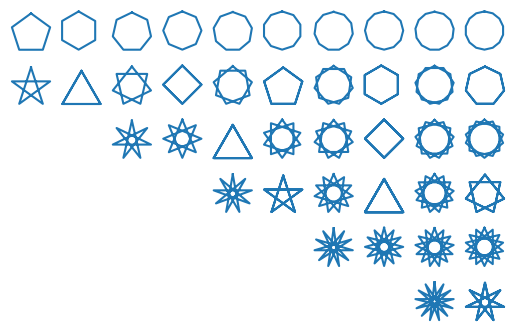
Any function of your interest
2. Classes#
Extend the
Cell,gCellorCultureclass with new methods, such as:
cells with other shapes, e.g. ellipse, polygon,…
move to avoid overlap with another cell
connect with another cell like a neuron
growth based on the environment, e.g., number of neighbors
…
# example of drawing an ellipse
import matplotlib.patches as pat
p = pat.Ellipse(xy=(1,2), width=2, height=1, angle=30)
plt.gca().add_patch(p)
plt.axis('equal');
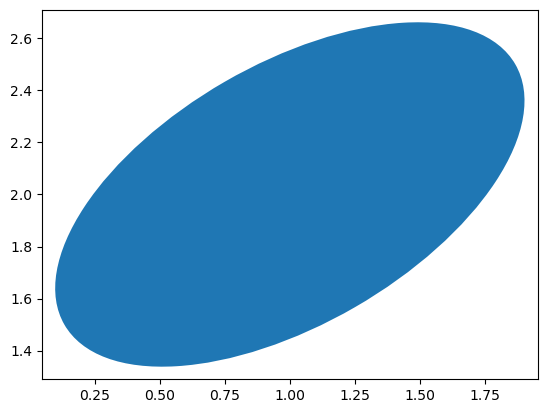
# example of drawing a polygon
xy = np.array([[np.sin(th),np.cos(th)] for th in np.arange(0, 4*np.pi, np.pi*4/5)])
p = pat.Polygon(xy)
plt.gca().add_patch(p)
plt.axis('equal');
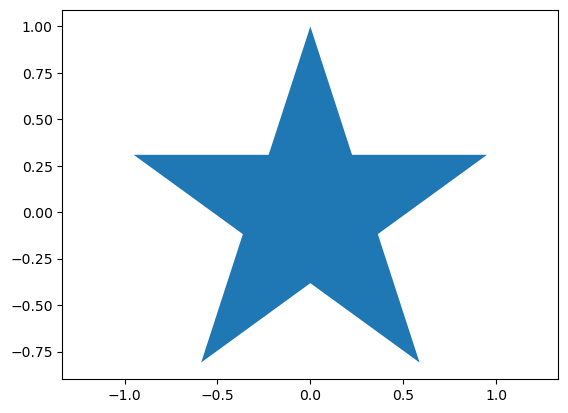
class Cell:
"""Class for a cell"""
def __init__(self, position = [0,0], radius=0.1, color=[1,0,0,0.5]):
"""Make a new cell"""
self.position = np.array(position)
self.radius = radius
self.color = color
def show(self):
"""Visualize as a circule"""
c = plt.Circle(self.position,self.radius,color=self.color)
plt.gca().add_patch(c)
plt.axis('equal')
class Neuron(Cell):
"""Neuron class based on Cell class"""
def __init__(self, position=[0,0], radius=0.2, color=[1,0,0,0.5]):
"""Create a neuron"""
super().__init__(position=position, radius=radius, color=color) # call the constructor of Cell class
self.naxon = 0 # number of axons
self.axon = [] # base and termian positions of axons
def connect(self, target):
"""Connect axon to a target neuron"""
vec = target.position - self.position # vector to the target center
vec = vec/np.sqrt(sum(vec**2)) # normalize to length 1
base = self.position + self.radius*vec # base of the axon
term = target.position - target.radius*vec # synaptic terminal
self.axon.append(np.array([base,term]))
self.naxon += 1 # increment the axon number
def show(self):
"""show the neuron with axons"""
super().show() # show the cell body
for i in range(self.naxon):
plt.plot(self.axon[i][:,0], self.axon[i][:,1], c=self.color) # axon
plt.plot(self.axon[i][-1,0], self.axon[i][-1,1], 'o', c=self.color) # synaptic terminal
# Neurons with no connections
n1 = Neuron()
n2 = Neuron([1,0], color='g')
n3 = Neuron([0.5,1], color='b')
n1.show(); n2.show(); n3.show();
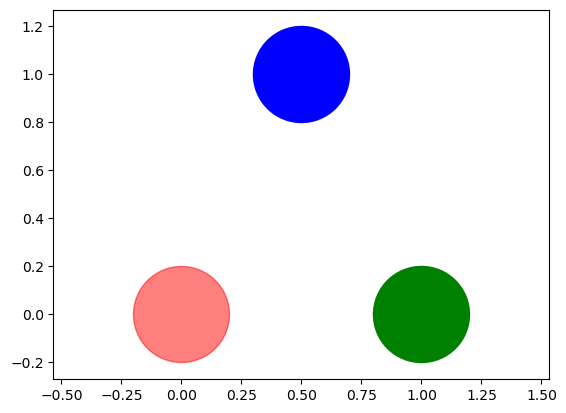
# Triangular connections
n1.connect(n2)
n2.connect(n3)
n3.connect(n1)
n1.show(); n2.show(); n3.show();
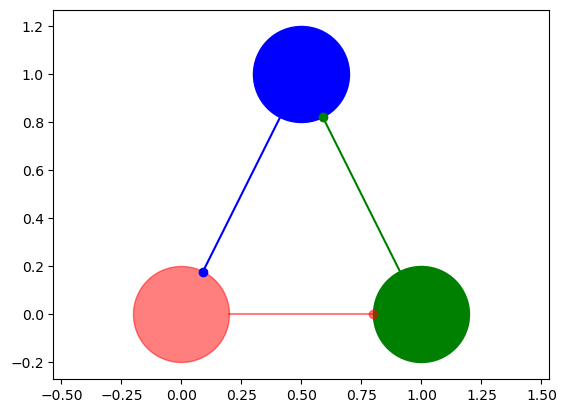
Save the defined class(es) as a module
cell.py.
Import the module and test how it works.
import cell
import importlib
importlib.reload(cell) # This is needed after updating a module
<module 'cell' (namespace) from ['/Users/doya/OIST Dropbox/kenji doya/Python/iSciComp/cell']>
# Neurons with no connections
n1 = cell.Neuron()
n2 = cell.Neuron([1,0], color='g')
n3 = cell.Neuron([0.5,1], color='b')
# Triangular connections
n1.connect(n3)
n2.connect(n1)
n3.connect(n2)
n1.show(); n2.show(); n3.show();
---------------------------------------------------------------------------
AttributeError Traceback (most recent call last)
Cell In[20], line 2
1 # Neurons with no connections
----> 2 n1 = cell.Neuron()
3 n2 = cell.Neuron([1,0], color='g')
4 n3 = cell.Neuron([0.5,1], color='b')
AttributeError: module 'cell' has no attribute 'Neuron'


